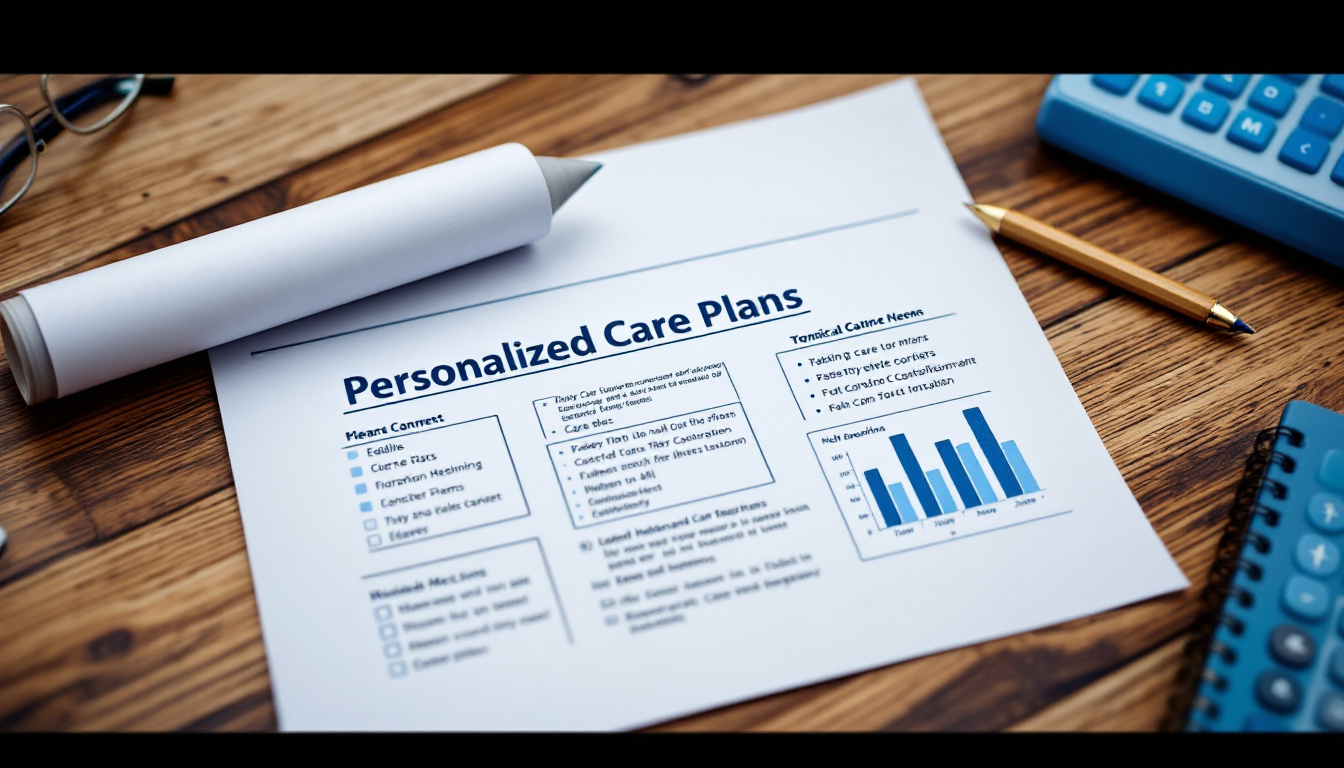How Follow-Up Visits Reduce Hospital Readmissions for Seniors
Reducing Senior Readmissions: The Critical Role of Follow-Up Visits

Introduction
Hospital readmissions pose a significant risk to the health and well-being of senior patients, often complicating recovery and increasing healthcare costs. Follow-up visits have emerged as a crucial strategy in mitigating these risks, offering a structured pathway to monitor and reduce hospital readmissions among older adults. This article explores how timely follow-up care and interventions can significantly impact readmission rates, the methodologies involved, and the benefits for seniors transitioning from hospital to home care.
The Importance of Follow-Up Care Post-Hospitalization
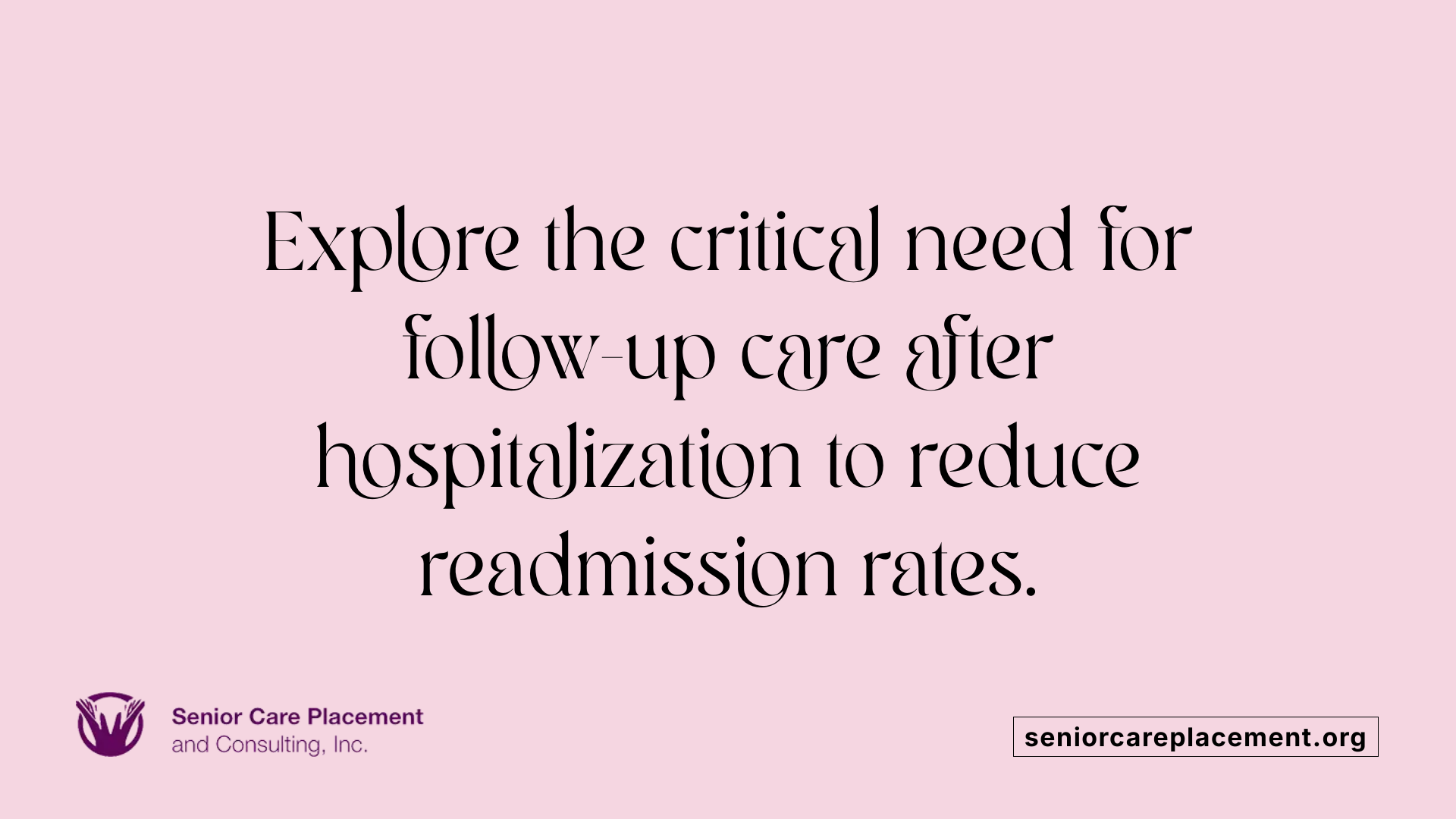
Why is follow-up care after hospitalization important for seniors?
Follow-up care after hospitalization is crucial for seniors as it significantly reduces the likelihood of readmission, particularly for those with multiple chronic conditions.
Research indicates that early post-discharge contact with healthcare providers can prevent up to 20% of readmissions in these patients if made within 14 days of discharge. For instance, those who received community nursing follow-ups showed a striking readmission rate of only 9% compared to 16% for those without such contact.
Additionally, programs like Kindred AfterCare provide structured support through multiple check-ins, enhancing patient engagement and satisfaction post-discharge. Early interventions not only address immediate health concerns but also facilitate medication management, education on self-care, and enable timely referrals, critical for avoiding complications.
Studies highlight that follow-up care, whether through telephone calls or outpatient visits, yields similar levels of patient satisfaction and promotes recovery effectively. Ultimately, proactive follow-up contributes to better health outcomes, improved patient satisfaction, and reduced overall healthcare costs.
Impact on readmission rates
According to data, individuals receiving follow-up visits have demonstrated a significantly lower readmission rate. For example, patients with post-discharge follow-up visits had a readmission rate of 7.30%, starkly lower than that of 18.27% for those without any follow-up scheduled.
Early intervention benefits
Outcomes from interventions point to the efficacy of early follow-up. A mere home visit within three days of discharge has been shown to be one of the most effective methods to lower readmission rates among older adults.
Programs supporting senior care
Innovative programs such as the Hospital at Home initiative and Transitional Care Management (TCM) have shown remarkable success in reducing readmission rates. TCM, for instance, has led to an 86.6% reduction in readmissions by ensuring comprehensive discharge planning and medication reconciliation, highlighting the multifaceted approach necessary for effective senior care.
Timing of Follow-Up Visits and Impact on Senior Readmissions
What is the optimal timing for physician visits after hospital discharge to reduce readmissions among seniors?
Follow-up visits after hospital discharge are crucial for reducing readmissions among seniors. Research indicates that the timing of these appointments may significantly influence their effectiveness.
Results reveal that in-person physician visits conducted early after discharge lead to a substantial decrease in hospital readmissions. For example, a decrease of 67.8 readmissions per 1,000 discharges was observed when a physician visit occurred within 7 days of discharge. Furthermore, this impact grows even more pronounced with time, as visits within 21 days resulted in a reduction of 110.0 fewer readmissions per 1,000 discharges.
Statistical impact of timely follow-ups
Various studies emphasize the strong protective effect of timely follow-up visits. For instance, patients with follow-up appointments scheduled within 2 days of discharge showed an adjusted odds ratio of 0.72 for reduced readmission rates, highlighting the importance of early intervention.
The analysis of readmission statistics demonstrates that patients with follow-up visits experienced a significantly lower readmission rate of 7.30% compared to 18.27% among those without any follow-up scheduled within 30 days. The benefits of timely follow-ups underscore the need for healthcare providers to prioritize these appointments for seniors, ultimately aiding in the prevention of unnecessary readmissions.
Effective Strategies to Reduce Readmissions Among the Elderly
What strategies can hospitals use to decrease readmission rates among elderly patients?
Reducing readmission rates among elderly patients requires hospitals to deploy a variety of strategies that tackle multiple facets of care. Implementing comprehensive patient needs assessments is crucial; this helps healthcare teams understand the specific challenges and requirements of each patient after discharge.
Medication reconciliation plays a vital role in preventing confusion and errors. By ensuring patients understand their medications, the likelihood of complications and subsequent readmissions is diminished. Furthermore, thorough patient education empowers seniors to manage their health better.
Timely Follow-Up and Support
Scheduling timely outpatient follow-up appointments is also critical. Studies indicate that follow-ups within 7 days can significantly lower readmission risks. Alongside in-person visits, conducting telephone check-ins post-discharge creates a safety net, keeping lines of communication open and addressing issues before they escalate.
Incorporating transitional care personnel into the care continuum ensures that patients receive consistent support during the critical transition phase. This may include community partnerships that connect patients to local resources, enhancing their access to necessary care.
Targeting High-Risk Patients
Utilizing risk stratification methods allows hospitals to identify high-risk patients early. Tailoring interventions specifically for this group can effectively reduce unnecessary readmissions. The overall objective is to create a holistic support system that not only addresses medical needs but also empowers elderly patients to take charge of their health, ultimately leading to improved patient outcomes.
Coleman's Four Pillars of Care for Preventing Readmissions
What are the four pillars of care to prevent unnecessary readmissions for seniors?
Coleman's "Four Pillars" of care transition activities serve as a crucial framework in reducing unnecessary readmission rates among older adults. These pillars include:
- Medication Management: Ensuring that patients understand their prescriptions, dosages, and potential side effects, as well as facilitating medication reconciliation to prevent errors during transitions.
- Patient-Centered Health Records: Providing accessible health records that contain vital information about the patient’s medical history, treatment plans, and immediate healthcare needs, enhancing communication with healthcare providers.
- Follow-Up Visits with Providers and Specialists: Arranging timely follow-up appointments post-discharge helps monitor patient recovery, address any complications swiftly, and ensures continuity of care.
- Patient Knowledge of Red Flags: Educating patients on symptoms that signal worsening conditions or adverse drug reactions, empowering them to seek help before complications arise.
Implementing these strategies not only enhances patient engagement but also fosters a proactive approach to healthcare that can significantly reduce the likelihood of hospital readmissions among seniors.
Statistics of Follow-Up Visits and Hospital Readmissions
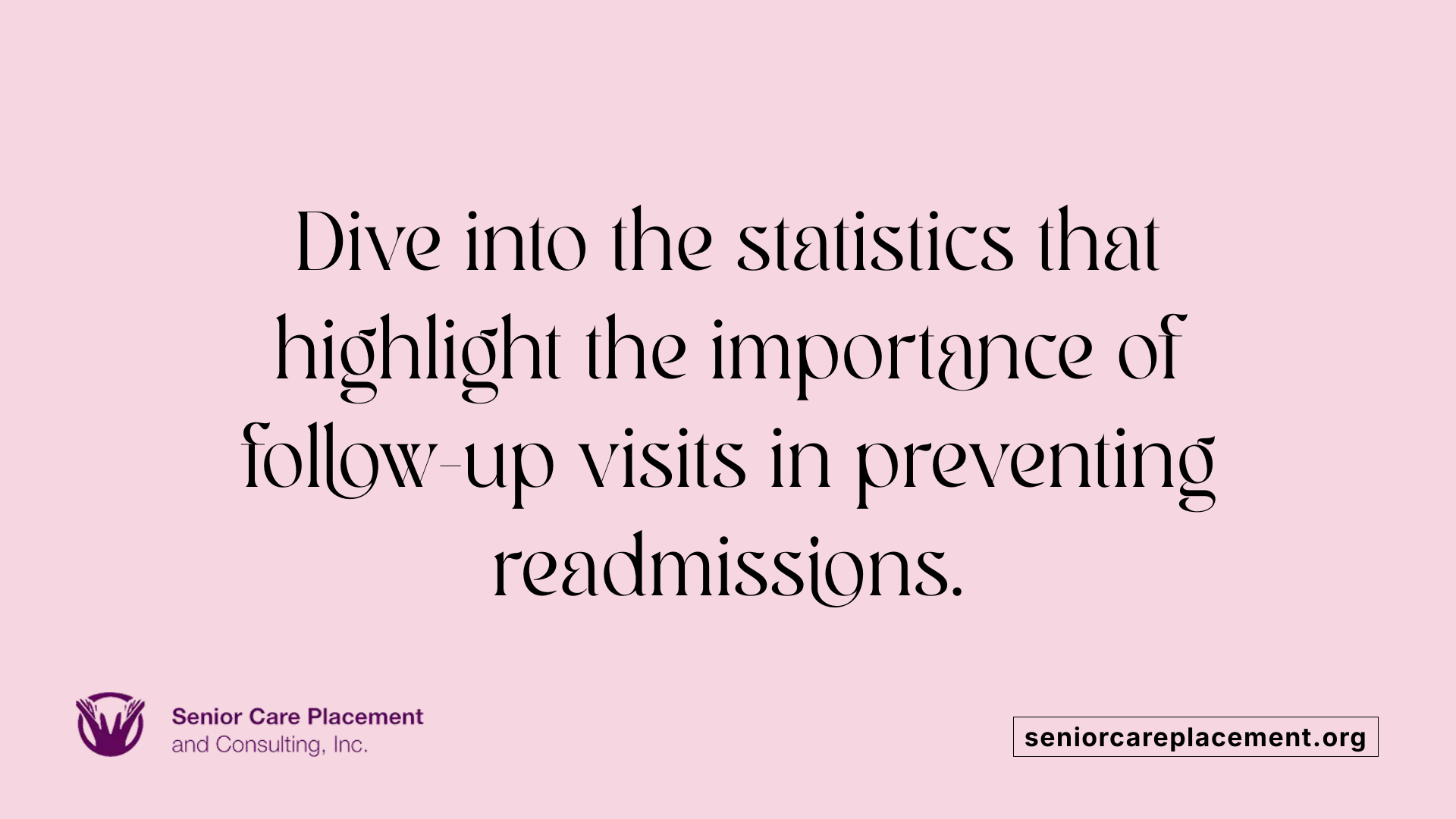
Current readmission statistics
Hospital readmissions among elderly patients represent a significant challenge in health care. Approximately 15% of elderly patients experience readmission within 28 days of discharge, a statistic that highlights the necessity for effective transitional care. The financial implications are also thought-provoking, as unplanned readmissions contribute to healthcare costs exceeding $17 billion annually while posing health risks, including infections and rapid deterioration in conditions.
Impact of follow-up visits
Research indicates that follow-up visits are instrumental in reducing these readmission rates. A service evaluation revealed that community nursing contact lowered the readmission rate from 15.67% to 9.24%. Furthermore, an important study highlighted that timely follow-up appointments could decrease the likelihood of readmission by up to 32% when involving a multidisciplinary geriatric team.
A systematic review of various studies reflects a pooled effect showing that outpatient follow-ups reduce 30-day all-cause readmissions by 21%, particularly benefiting patients with conditions like heart failure. Due to the varied impact of follow-up visits noted across studies, a combination of comprehensive discharge planning, timely communication, and medication management can further enhance these efforts, ultimately leading to improved health outcomes for seniors.
Community Nurse Initiatives Lower Readmission Rates
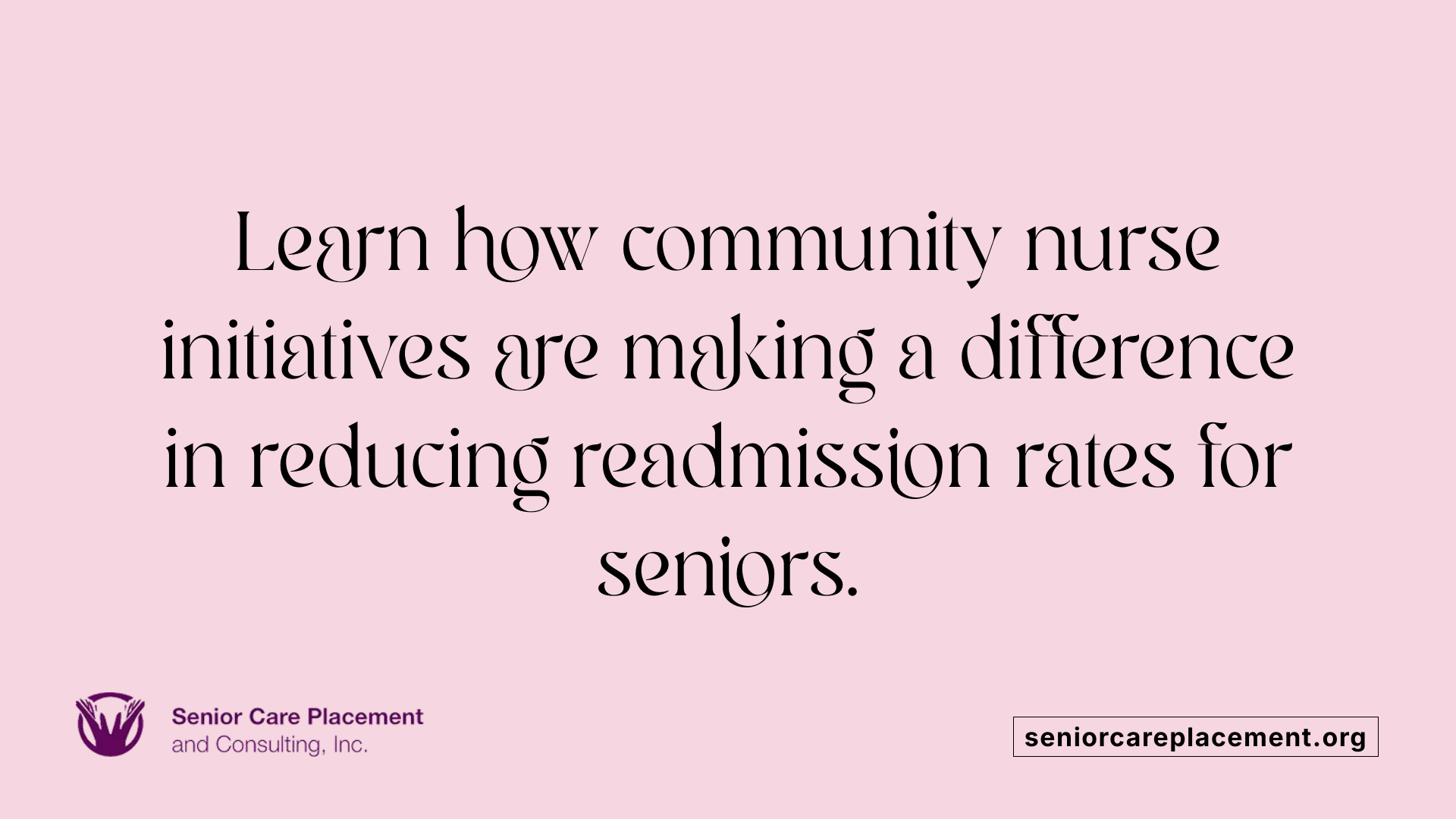
Case Study: Community Nurse Follow-Ups
A noteworthy service evaluation highlighted the effectiveness of follow-up visits by community nurses for elderly patients. When these nurses contacted patients post-discharge, the readmission rate notably decreased from 15% to 9.24%. This demonstrates a clear trend whereby proactive communication plays a crucial role in managing patient health post-discharge.
In this study involving 756 elderly patients, those contacted by community nurses were nearly twice as likely to avoid readmission as those who received no follow-up, reflected by an odds ratio of 1.93. This substantial reduction in readmission underscores the value of tailored interventions and support.
Readmission Rate Reduction Statistics
Statistics reveal that follow-up visits can lead to considerable decreases in hospital readmission rates. For instance, the cumulative incidence of readmission was 39.8% in patients without follow-up by an Outgoing Multidisciplinary Geriatric Team (OGT), compared to just 30.2% for those who received home visits and assessments within a week post-discharge — a reduction of about 28%.
Furthermore, routine follow-up care can diminish readmissions by up to 41%, indicating that simple measures such as home visits and phone calls can significantly improve health outcomes for elderly patients. Overall, these community nurse interventions not only reduce the chances of readmissions but also enhance the overall well-being of seniors following their hospital stays.
The Role of Multidisciplinary Teams in Follow-Up Visits
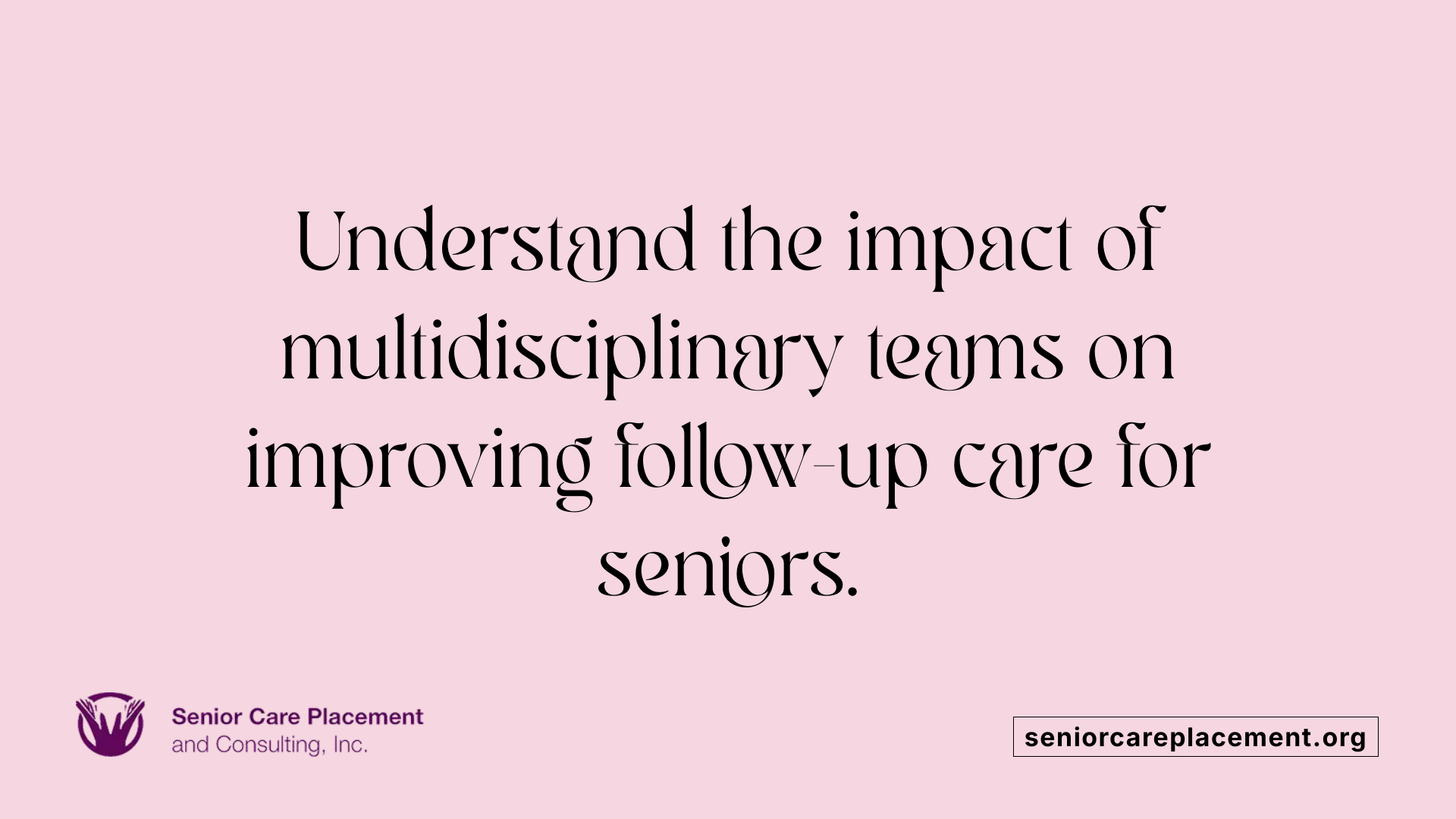
Comprehensive Care by Multidisciplinary Teams
Multidisciplinary teams (MDTs) play an essential role in ensuring effective follow-up care for seniors post-discharge. These teams typically include physicians, nurses, pharmacists, and social workers who collaborate to provide comprehensive support tailored to patients' needs.
Through their coordinated efforts, MDTs focus on critical areas such as medication reconciliation, chronic disease management, and early identification of health risks. This collaborative approach not only improves the quality of care but also reduces the likelihood of readmission.
Benefits for Seniors
Studies demonstrate that seniors who engage with MDT follow-up visits experience significant benefits. One landmark study indicated that patients receiving follow-up visits within one week of discharge reported a 32% lower risk of readmission compared to those who did not receive similar outreach.
Additionally, MDT interventions have shown an impressive 48% reduction in readmission rates among elderly patients when comprehensive evaluations and personalized care plans are implemented. This model improves patient satisfaction, as seniors receive attentive care that addresses their unique challenges, ultimately enhancing their overall health outcomes.
| Benefits | Impact on Seniors | Outcome |
|---|---|---|
| Comprehensive Assessments | Highlights potential health risks | Reduces readmissions by 32% |
| Medication Reconciliation | Prevents medication errors | Enhances adherence to treatment plans |
| Tailored Health Management | Addresses chronic conditions | Improves overall health outcomes |
Home Visits and Their Efficiency in Reducing Readmissions
Advantages of home visit follow-ups
Home visit follow-ups post-discharge have shown to offer substantial benefits in reducing hospital readmission rates. Studies reveal that community nurses contacting patients within days of their discharge can lower readmission rates significantly. For instance, a study found that the readmission rate dropped to 9.24% with follow-up visits compared to 15.67% in the absence of contact.
These visits provide crucial support such as medication management, GP referrals, and educational resources that strengthen a patient’s ability to manage their health independently. The research indicates that follow-up visits significantly empower patients, leading to better health outcomes and lower likelihoods of worsening conditions that necessitate hospital readmission.
Supporting evidence from case studies
Multiple case studies reinforce the efficacy of home visits. In one study involving 756 patients, the group contacted by community nurses had nearly twice the odds (Odds Ratio of 1.93) of avoiding readmission compared to those without follow-up. Moreover, an intervention where geriatric teams conducted follow-up visits led to a reduction in readmissions from 23% to 12%, showcasing a 48% improvement.
Further analysis of transitional care revealed an 86.6% reduction in readmission likelihood when effective follow-up care was employed, highlighting the importance of structured post-discharge management. Overall, these findings illustrate that home visits contribute significantly to reduced hospital stay lengths and enhanced patient satisfaction, emphasizing their role in an effective healthcare strategy.
Transitional Care Management (TCM) and Readmission Rates
What are the key components of Transitional Care Management (TCM)?
Transitional Care Management (TCM) is designed to enhance the continuity of care for patients post-discharge, focusing on thorough follow-up processes. Important components of TCM include:
- Comprehensive Discharge Planning: Involves preparing patients and caregivers for post-discharge care, addressing the patient’s specific needs.
- Medication Reconciliation: Ensures that medications are accurately updated to prevent errors during transitions, an issue that affects a significant proportion of patients.
- Patient Education: Engaging patients in their health care promotes a better understanding of their plans and medications, enhancing adherence and participation.
How does TCM impact senior care outcomes?
Research indicates that implementing TCM leads to substantial benefits, particularly for seniors. For instance:
- Reduced Readmission Rates: TCM has shown an 86.6% likelihood decrease in readmissions among those who participate, contributing to lower overall healthcare costs.
- Improved Patient Engagement: Tailored education and follow-up care empower patients, leading to better self-management and fewer complications post-discharge.
- Lower Hospitalization Length: Patients receiving TCM often demonstrate shorter hospital stays, maximizing resource efficiency.
| Component | Importance | Impact on Outcomes |
|---|---|---|
| Comprehensive Discharge Planning | Organizes post-discharge support | Helps prevent readmissions through effective care transitions |
| Medication Reconciliation | Reduces errors during transitions | Critical for ensuring correct medication regimens |
| Patient Education | Engages patients in care | Enhances adherence to treatment and self-management |
Adopting TCM strategies may yield significant improvements in managing the health of elderly patients, reducing their risk of unplanned readmissions.
The Critical Role of Post-Discharge Surveillance
Monitoring to Prevent Complications
Post-discharge follow-up is essential for elderly patients, who face significant risks associated with hospital readmissions. Approximately 15% of seniors are readmitted within 28 days of discharge. This alarming rate underscores the necessity of effective monitoring strategies that can prevent complications that lead to these readmissions.
Studies show that timely follow-up visits, particularly within the first week after discharge, can dramatically impact readmission rates. For example, a group contacted by community nurses had a reduced readmission rate of 9.24%, suggesting that consistent monitoring helps identify health issues early and enhances patient adherence to treatment plans.
Role of Surveillance in Senior Healthcare
Surveillance after discharge serves as a vital tool in managing healthcare for seniors. Through close monitoring, healthcare providers can effectively coordinate care, conduct medication reconciliations, and educate patients on self-management. Interventions like the Hospital at Home program demonstrate how organized surveillance can lead to significant reductions in readmissions, with some studies reporting rates as low as 7% for patients receiving home-based care compared to 23% for traditional inpatient care.
This effective strategy not only addresses health concerns but also fosters a continuous care environment, ensuring that elderly patients receive comprehensive support that aligns with their evolving healthcare needs.
Hospital at Home: An Innovative Solution
Program Benefits
The Hospital at Home program offers a groundbreaking approach to healthcare by delivering hospital-level care directly in patients' homes. This program addresses a critical need to improve patient outcomes and alleviate hospital congestion, especially for seniors who may face complications during traditional hospital stays.
Patients participating in the Hospital at Home program benefit from personalized care tailored to their specific health needs. This not only enhances their comfort but also allows for greater patient satisfaction. Reports indicate that patients in this program are four times more likely to express satisfaction with their physician compared to traditional inpatient care.
Reduction in Readmissions
The impact of the Hospital at Home program on reducing hospital readmissions is significant. Research shows that participants had readmission rates of only 8.6%, as opposed to 15.6% for traditional inpatient care. Moreover, 30-day readmission rates were reported at just 7% for Hospital at Home patients compared to 23% for those who received conventional care.
Overall, these findings indicate that the shift toward home-based care in the Hospital at Home program not only enhances patient comfort and satisfaction but also plays a vital role in minimizing hospital readmissions, ultimately reducing healthcare costs and improving health outcomes for seniors.
Outpatient Follow-Ups and Specific Conditions
Conditions Benefiting from Follow-Ups
Outpatient follow-ups after hospital discharge have shown significant benefits for certain chronic conditions, particularly heart failure and stroke. Research indicates that these follow-ups can lead to a 27% reduction in readmission rates for heart failure patients, highlighting the critical need for structured post-discharge care.
Patients with chronic obstructive pulmonary disease (COPD) also merit attention. Despite the lack of robust evidence for follow-up effectiveness in this area due to study quality issues, necessary support and ongoing management could potentially yield benefits not yet fully explored.
Impact on Chronic Disease Management
Follow-up visits serve as vital checkpoints for managing chronic diseases effectively. They allow healthcare providers to perform medication reconciliation, educate patients on self-management, and address any emerging health issues. This proactive approach leads to better health outcomes and encourages patient engagement in their care.
A systematic review covering various studies indicates that outpatient follow-ups are especially beneficial in preventing readmissions, particularly for patients suffering from conditions like heart failure and stroke. Notably, follow-ups within a week of discharge significantly decrease readmission risks.
| Condition | Readmission Reduction | Comments |
|---|---|---|
| Heart Failure | 27% | Significant clinical benefit from follow-ups |
| Stroke | Effective | Supports recovery and management |
| COPD | Unknown | Need for further research due to study variability |
| General Aging | 67% | Patients with follow-ups show much lower rates |
Financial Implications of Reduced Readmissions
Cost Savings
Reducing hospital readmissions, particularly for seniors, presents significant financial benefits across the healthcare system. For instance, patients who had follow-up visits after discharge exhibited annual health expenditures approximately $10,000 lower compared to those who did not. This reduction can be attributed to decreased medical interventions, fewer hospitalizations, and better management of chronic conditions when ongoing care is maintained.
Revenue Impact on Healthcare Facilities
Healthcare facilities that successfully lower readmission rates stand to benefit from both enhanced patient outcomes and smoother operations. Programs like the Hospital Readmission Reduction Program (HRRP) incentivize hospitals to improve care, thus reinforcing revenue streams by reducing penalties associated with high readmission rates. For hospitals that engage in effective transitional care management, the potential 41% reduction in readmissions translates into considerable savings by minimizing the financial strain of treating avoidable complications and extending hospital stays.
Table of Cost-Related Benefits of Reducing Readmissions
| Type of Impact | Description |
|---|---|
| Cost Savings | Lower overall health expenditures due to reduced unplanned hospital stays. |
| Revenue Growth | Enhanced hospital revenues through improved care and reduced penalties. |
| Patient Flow | Alleviation of bed shortages and better resource allocation in healthcare. |
| Quality of Care | Improved patient satisfaction and health outcomes leading to better reputation. |
Addressing Disparities Through Follow-Up Care
How Do Social and Demographic Factors Affect Readmissions?
The incidence of hospital readmissions varies significantly across different social and demographic groups, revealing underlying disparities in healthcare access and outcomes. One striking finding indicates that follow-up care significantly mitigates these disparities. For example, timely follow-up interventions accounted for a substantial portion of increased readmission rates among non-Hispanic Black beneficiaries hospitalized for pneumonia when compared to their white counterparts. This shows that effective follow-up care can bridge some gaps in healthcare access, especially for marginalized communities.
What Role Does Healthcare Equality Play in Readmission Rates?
Implementing robust follow-up care strategies promotes healthcare equality by addressing the needs of high-risk populations. By ensuring that follow-up services are timely and targeted, healthcare providers can help manage chronic conditions, and enhance patient education. Studies suggest that patients within marginalized demographic groups benefit the most from structured follow-up appointments. Specifically, enhancing outpatient follow-up visits can reduce readmission rates significantly and lead to improved health outcomes.
Table of Findings on Follow-Up Care's Impact on Readmissions
| Study Aspect | Findings | Implications of Findings |
|---|---|---|
| Demographic Disparities | Significant reduction in readmission for non-Hispanic Black patients with follow-up | Shows the importance of targeted care |
| Effects of Timely Follow-Up | 97.5% of increased readmission risk related to follow-ups | Indicates follow-up is crucial |
| Health Outcomes | Enhanced engagement showed lower risks of complications | Emphasizes role of patient education |
Efforts to reduce disparities in follow-up care can lead to better health outcomes not just for individuals, but for entire communities.
Future Directions in Reducing Readmissions for Seniors
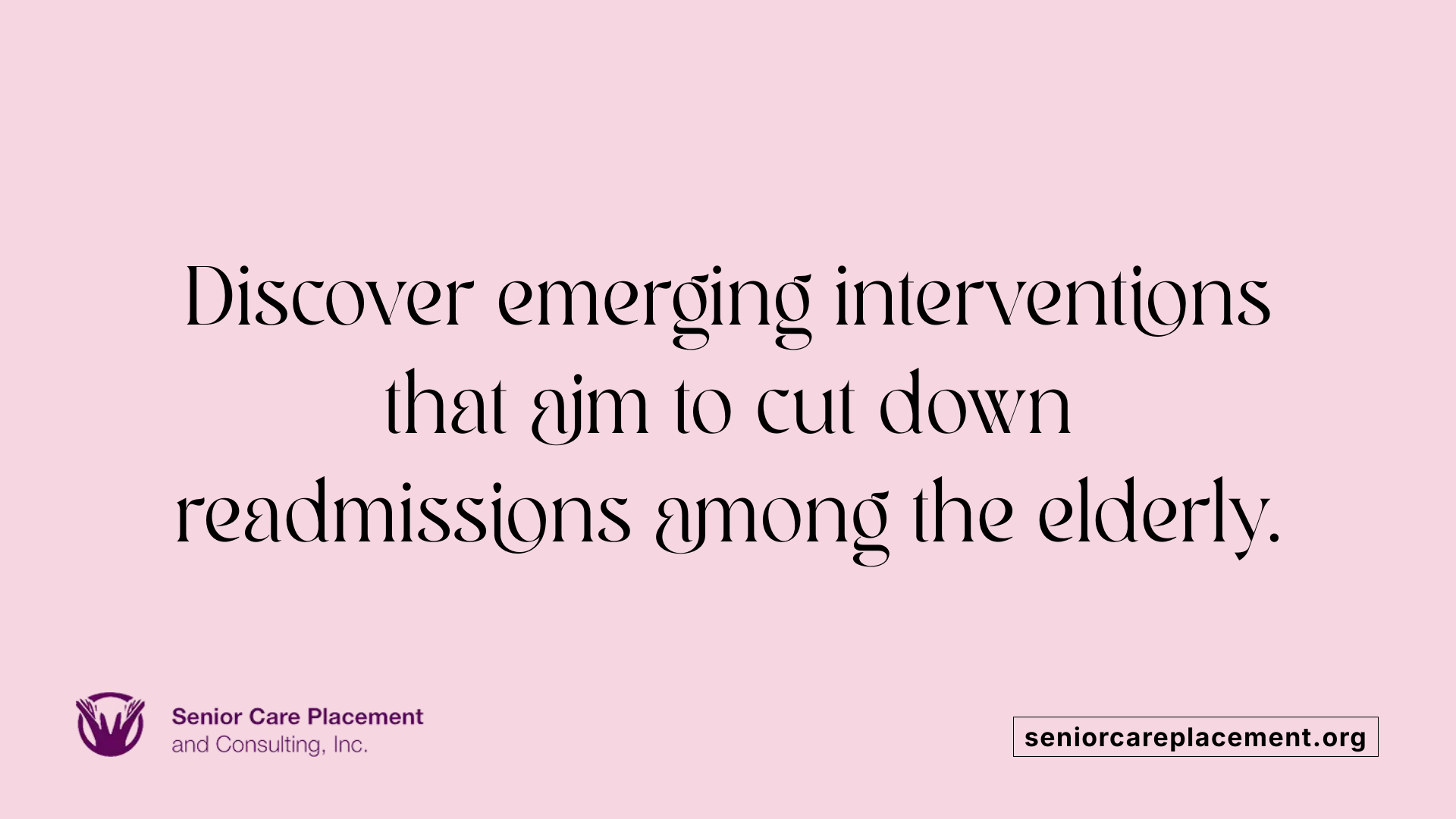
Emerging Interventions
Recent studies showcase a variety of innovative interventions aimed at reducing hospital readmissions among seniors.
- Transitional Care Management (TCM): TCM programs have demonstrated an impressive 86.6% reduction in readmission likelihood. This approach emphasizes follow-up care, medication management, and patient education.
- Hospital at Home Programs: These initiatives provide hospital-level care in patients' homes, significantly lowering readmission rates and improving patient satisfaction compared to traditional inpatient care.
- Community Nurse Follow-ups: Engaging community nurses post-discharge has proven effective in reducing readmission rates. For instance, follow-ups reduced the readmission rate from 15% to 9%.
Potential Research Avenues
As the landscape of post-hospital care evolves, several research directions hold promise for enhancing health outcomes:
- Exploring the Impact of Timing: Investigating the optimal timing for follow-up visits to maximize their impact on readmission rates is crucial. Early interventions could be particularly beneficial for high-risk patients.
- Comprehensive Interventions: Evaluating the effectiveness of multi-faceted approaches that integrate occupational therapy, medication reconciliation, and personalized care plans.
- Addressing Disparities in Care: Understanding how socioeconomic factors contribute to readmission risks could inform targeted strategies to improve access to follow-up care for underserved populations.
Future efforts targeting these areas have the potential to significantly enhance the care and quality of life for older adults.”} raw_value=
Conclusion
Follow-up visits are vital in preventing unnecessary hospital readmissions, offering a clear path to better health outcomes for seniors. By implementing structured follow-up programs and utilizing data-driven strategies, healthcare providers can significantly reduce readmission rates. As the healthcare landscape evolves, the integration of technologies and innovative care models will further bolster efforts to minimize readmissions and enhance the quality of life for senior patients. Continuous research and policy development are imperative to ensure that seniors receive the most effective post-discharge care, leading to more sustainable healthcare systems.
References
- Reducing readmission rates through a discharge follow-up service
- Does geriatric follow-up visits reduce hospital readmission among ...
- Outpatient Follow-Up Visits to Reduce 30-Day All-Cause ... - CDC
- Early geriatric follow-up after discharge reduces readmissions
- Simple follow-up 'aftercare' could reduce hospital readmissions in ...
- Effect of single follow-up home visit on readmission in a group of frail ...
- Hospital Readmissions Reduction Program (HRRP) - CMS
- Hospital at Home Care Reduces Costs, Readmissions, and ...
- Follow-up PCP visits again shown to reduce hospital readmissions





























































